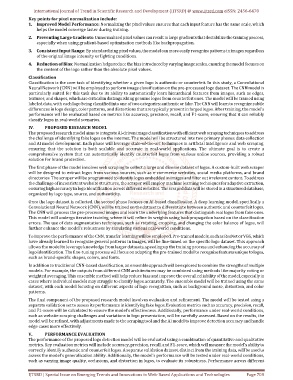Page 718 - Emerging Trends and Innovations in Web-Based Applications and Technologies
P. 718
International Journal of Trend in Scientific Research and Development (IJTSRD) @ www.ijtsrd.com eISSN: 2456-6470
Key points for pixel normalization include:
1. Improved Model Performance: Normalizing the pixel values ensures that each input feature has the same scale, which
helps the model converge faster during training.
2. Preventing Large Gradients: Unnormalized pixel values can result in large gradients that destabilize the training process,
especially when using gradient-based optimization methods like backpropagation.
3. Consistent Input Range: By standardizing pixel values, the model can more easily recognize patterns in images regardless
of the original image intensity or lighting conditions.
4. Reduction of Bias: Normalization helps reduce the bias introduced by varying image scales, ensuring the model focuses on
the content of the logo rather than the absolute pixel values.
Classification
Classification is the core task of identifying whether a given logo is authentic or counterfeit. In this study, a Convolutional
Neural Network (CNN) will be employed to perform image classification on the pre-processed logo dataset. The CNN model is
particularly suited for this task due to its ability to automatically learn hierarchical features from images, such as edges,
textures, and shapes, which are critical in distinguishing genuine logos from counterfeit ones. The model will be trained using
labeled data, with each logo being classified into one of two categories: authentic or fake. The CNN will learn to recognize subtle
differences in logo design, color patterns, and distortions that are typically present in forged logos. After training, the model’s
performance will be evaluated based on metrics like accuracy, precision, recall, and F1-score, ensuring that it can reliably
classify logos in real-world scenarios.
IV. PROPOSED RESEARCH MODEL
The proposed research model aims to integrate AI-driven image classification with efficient web scraping techniques to address
the challenge of identifying fake logos on the internet. The model will be structured into two primary phases: data collection
and AI model development. Each phase will leverage state-of-the-art techniques in artificial intelligence and web scraping,
ensuring that the solution is both scalable and accurate in real-world applications. The ultimate goal is to create a
comprehensive system that can automatically identify counterfeit logos from various online sources, providing a robust
solution for brand protection.
The first phase of the model involves web scraping to collect a large and diverse dataset of logos. A custom-built web scraper
will be designed to extract logos from various sources, such as e-commerce websites, social media platforms, and brand
directories. The scraper will be programmed to identify logos embedded in images and filter out irrelevant content. To address
the challenge of inconsistent website structures, the scraper will employ machine learning techniques for adaptive extraction,
ensuring high accuracy in logo identification across different websites. The scraped data will be stored in a structured database,
organized by logo type, source, and authenticity.
Once the logo dataset is collected, the second phase focuses on AI-based classification. A deep learning model, specifically a
Convolutional Neural Network (CNN), will be trained on the dataset to differentiate between authentic and counterfeit logos.
The CNN will process the pre-processed images and learn the underlying features that distinguish real logos from fake ones.
This model will undergo iterative training, where it will refine its weights using backpropagation based on the classification
errors. The use of data augmentation techniques, such as rotating, cropping, and changing the color balance of logos, will
further enhance the model's robustness by simulating various real-world conditions.
To improve the performance of the CNN, transfer learning will be employed. Pre-trained models, such as ResNet or VGG, which
have already learned to recognize general patterns in images, will be fine-tuned on the specific logo dataset. This approach
allows the model to leverage knowledge from larger datasets, speeding up the training process and enhancing the accuracy of
logo identification. The fine-tuning process will focus on adapting the pre-trained model to recognize features unique to logos,
such as brand-specific shapes, colors, and fonts.
In addition to traditional CNN-based classification, an ensemble approach will be explored to combine the strengths of multiple
models. For example, the outputs from different CNN architectures may be combined using methods like majority voting or
weighted averaging. This ensemble method will help reduce bias and improve the overall reliability of the model, especially in
cases where individual models may struggle to classify logos accurately. The ensemble model will be trained using the same
dataset, with each model focusing on different aspects of logo recognition, such as background noise, distortion, and color
patterns.
The final component of the proposed research model involves evaluation and refinement. The model will be tested using a
separate validation set to assess its performance in identifying fake logos. Evaluation metrics such as accuracy, precision, recall,
and F1-score will be calculated to ensure the model's effectiveness. Additionally, performance under real-world conditions,
such as website scraping challenges and variations in logo presentation, will be carefully assessed. Based on the results, the
model will be refined, with adjustments made to the scraping tool and the AI model to improve detection accuracy and handle
edge cases more effectively.
V. PERFORMANCE EVALUATION
The performance of the proposed logo detection model will be evaluated using a combination of quantitative and qualitative
metrics. Key evaluation metrics will include accuracy, precision, recall, and F1-score, which will measure the model's ability to
correctly identify authentic and counterfeit logos. A separate validation dataset, distinct from the training data, will be used to
assess the model's generalization ability. Additionally, the model’s performance will be tested under real-world conditions,
such as varying image quality, occlusions, and distortion in logos, to evaluate its robustness. Performance across different
IJTSRD | Special Issue on Emerging Trends and Innovations in Web-Based Applications and Technologies Page 708

